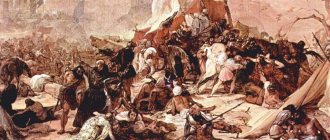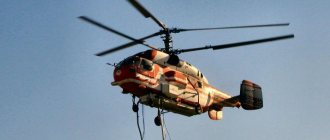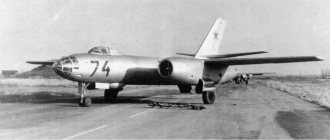GAZ-61
GAZ-61 on Wikimedia Commons
Total information
| Manufacturer | GAS |
| Years of production | 1941 — 1945 |
| Assembly | GAZ (Gorky, USSR) |
| Class | Average |
Design
| Body type(s) | 4-door sedan 2-door pickup and 4-door pickup phaeton |
| Layout | front-engine, all-wheel drive |
Engines
GAZ-11
| Brand: | GAZ-11 |
| Type: | Petrol |
| Volume: | 3,480 cm3 |
| Maximum power: | 85 l. s., at 3600 rpm |
| Maximum torque: | 196.2 Nm, at 1600 rpm |
| Configuration: | in-line, 6-cylinder. |
| Cylinders: | 6 |
| Valves: | 12 |
| Cylinder diameter: | 82 mm |
| Piston stroke: | 110 mm |
| Compression ratio: | 6,2 |
| Supply system: | Carburetor |
| Cooling: | liquid |
| Valve mechanism: | SV |
| Cylinder block material: | cast iron |
| Cylinder head material: | aluminum |
| Clock (number of clock cycles): | 4 |
| Cylinder operating order: | 1-5-3-6-2-4 |
Transmission
manual, four-speed, two-way, one-speed transfer case.
Characteristics
Mass-dimensional
| Length | 4800 mm |
| Width | 1770 mm |
| Height | 2080 mm |
| Clearance | 210 mm |
| Wheelbase | 2845 mm |
| Rear track | 1440 mm |
| Front track | 1440 mm |
| Weight | 1650 kg (61-73), 1540 kg (61-40) |
Dynamic
| Max. speed | 105 km/h |
On the market
| Predecessor Predecessor of the GAZ-M-21 - GAZ-M25 | Successor Successor GAZ-M-72 |
Other
| Load capacity | 400 kg |
| Fuel consumption | 17 l/100 km |
| Volume of the tank | 60 l. |
GAZ-61
- a family of Soviet light all-terrain vehicles with all-wheel drive. The GAZ-61-73 modification is the world's first all-wheel drive passenger car with a closed sedan body. During the Great Patriotic War, the GAZ-61-73 was actively used as a staff vehicle for the senior command staff of the Red Army.
Salon
These days, the cabin is cramped, although there is plenty of rear legroom. The interior is quite narrow, the headroom for the rear passenger is tight, and not everyone will be able to sit comfortably behind the wheel.
The only amenities in the car are a front sofa with forward-backward adjustment, a windshield that lifts for ventilation, an ashtray and a cigarette lighter.
The upholstery is made of overcoat cloth, most often gray or green. There is no heater in the cabin, so traveling long distances in winter is problematic, although the cloth still helps to keep the cabin warm.
American equivalent
Gas M1 was created on the basis of the American Ford Model B. Soviet engineers received documentation in accordance with the current agreement with the Americans.
However, it is incorrect to say that GAZ simply copied the car and set up production. The Ford was poorly suited for use in the Soviet Union, so many changes were made to the design.
It is considered the first Soviet car, which is reflected even in the name of the model. M1 means “Molotov-First”, the letter M is a tribute to Vyacheslav Molotov, the chairman of the Council of People's Deputies of the USSR, after whom the plant was named at that time, and 1 means the first Soviet car.
Adaptation to Soviet operating conditions was carried out by a team of engineers under the leadership of A. A. Lipgart.
The Gorky plant had to prepare the model for production, as well as manufacture part of the production equipment independently.
Notes
- [warspot.ru/6481-polnyy-privod-dlya-protivotankovoy-artillerii All-wheel drive for anti-tank artillery | Military historical portal Warspot.ru]
- Sokolov Mikhail.
[www.mediaglobe.ru/img_out/All_08_KT.pdf CT chronograph. 70 years: cargo emka] // Commercial transport. - 2009. - Issue. 8 (76). — P. 92-93. - ↑ 1 2 Kuznetsov Alexander.
[abs.msk.ru/images/PDF2008/abs5_084_085_Jeep.pdf Workers of that war] // Automobile and Service: magazine. — 2008, May. — Vol. 5. - Gogolev L. D.
Cars-soldiers: Essays on the history of development and military use of cars. - M.: Patriot, 1990. - 191 p. — 100,000 copies. — ISBN 5-7030-0226-5.
Armored cars
Fiat-Izhora
Fiat-Izhora" is a light machine-gun armored vehicle, used first in the Armed Forces of the Russian Empire, and later in the Red Army. The car was developed on the basis of a Fiat car chassis, produced under license in the USA. Although the development of the project and the purchase of the chassis took place back in 1916, mass production of armored vehicles was launched only after the February Revolution. From 1917 to 1918, about 80 copies of the armored car were built at the Izhora plant.
Armored vehicles were actively used by the Workers 'and Peasants' Red Army in the battles of the Civil War, being the second largest (after "Austins" of various types) in the armored units of the Red Army. Moreover, some armored cars, despite their “antiquity,” were used for military purposes during the Great Patriotic War.
FAI-M
FAI-M is a Soviet light armored car, which is, in fact, a modernization of the FAI armored car of the 30s. To build the car, the chassis of a GAZ-M1 or Ford-A passenger car (for FAI) was used. A total of 697 FAI and FAI-M armored vehicles were produced. The cars were produced from 1933 to 1939.
FAI and FAI-M armored vehicles were used in clashes at Lake Khasan and on the Khalkhin Gol River, in the Spanish Civil War, where 20 vehicles were delivered, in the Winter War (2 FAI were lost) and in the Great Patriotic War. FAI and FAI-M were used until 1943.
Body
The first cars were produced with a wooden roof frame, it was covered with leatherette. Later they started producing cars with an all-metal body - this became the main feature of the car.
It should be noted that the only passenger car in the USSR at that time was the Gas A with an open body type, so the Emka with an all-metal body was an innovation and a real breakthrough.
We mastered a new technology together with the bodybuilding division of Ford.
The profile of the front wings of the M1 differs from the Model B. For their production, new equipment was calculated and developed. The wings look more noble and better cover parts of the frame and suspension.
Paint colors
Most of the cars produced were painted black with a red stripe along the side. There were also green cars and very rarely gray ones.
Links
- Kuznetsov Alexander.
"Volga" GAZ-21 • GAZ-22 • GAZ-23 • GAZ-24 • GAZ-24-02 • GAZ-24-10 • GAZ-24-12 • GAZ-24-24 • GAZ-24-34 • GAZ-24- 76 • GAZ-24-95 • GAZ-3102 • GAZ-31022 • GAZ-31029 • GAZ-3105 • GAZ-3110 • GAZ-31105 • GAZ-311055 • GAZ-3111 • Volga Siber Executive models ZIM • Cars “Chaika” :
GAZ-13 “Chaika” ; GAZ-14 “Chaika”
• GAZ-3105All terrain GAZ-21 • GAZ-61 • GAZ-64 • GAZ-67 • GAZ-69 • M-72 • GAZ-46 • GAZ-2308 “Ataman” • GAZ-3106 Utility, sports and experimental models GAZ-4 • GAZ-61-417 • GAZ-A-Aero • GAZ-AAA • GAZ-VM • GAZ-25 • GAZ-GL-1 • GAZ-67-420 • M-73 • GAZ-16 • GAZ- 18 • GAZ-19 • GAZ-415 • GAZ-3103 • GAZ-3107 • GAZ-2301 • GAZ-2304 “Burlak” • GAZ-3115 • GAZ-3301 • GAZ-2332 CityVan
Characteristics
| Name: | GAZ-M |
| Fuel: | Petrol |
| Volume: | 3,285 cm3 |
| Max. power: | 50 l. s., at 2800 rpm |
| Max. torque: | 166.8 Nm, at 1300 rpm |
| Max. speed: | 105 km/h |
| Acceleration 0-100 km/h: | up to 80 km/h 24 sec. |
| Consumption per 100 km: | 14.5 l. |
| Recommended fuel: | A-66 or A-70 |
| Mechanical: | 3 steps |
Dimensions and weight:
| Length: | 4625 mm |
| Width: | 1770 mm |
| Height: | 1780 mm |
| Ground clearance: | 210 mm |
| Wheelbase: | 2845 mm |
| Front track: | 1435 mm |
| Rear track: | 1440 mm |
| Weight: | 1370 kg |
Engine
There are often mentions that GAZ replaced the eight-cylinder engine with an inline four, but this is not entirely true. Ford Model B was produced with both 4 and 8 cylinder engines, and the basis for the GAZ M1 was the 4 cylinder version - Ford Model B 40A Fordor Sedan.
At GAZ at that time it was not possible to launch and master the production of a V8 engine, so a simpler and cheaper 4-cylinder engine was installed on the cars.
It is important that the V8 engine did not have much superiority over the 4-cylinder. Engine capacity is 3.6 and 3.5 liters, power 65 and 50 hp, respectively. Therefore, the decision made at GAZ to produce a car with a simpler engine is completely justified.
Gas M1 with a V8 engine was still produced. The eight-cylinder engine was installed on cars for the needs of the NKVD.
The four-cylinder Gaz-A engine was modernized in the image of the Model B. The equipment for manufacturing the engine was completely Soviet.
Unlike Ford, whose engine was rigidly mounted on the frame, Soviet engineers developed a floating suspension on rubber cushions, which made it possible to significantly reduce transmitted vibration.
Subsequently, this engine was installed on Gaz-AA, MM trucks and their modifications.






